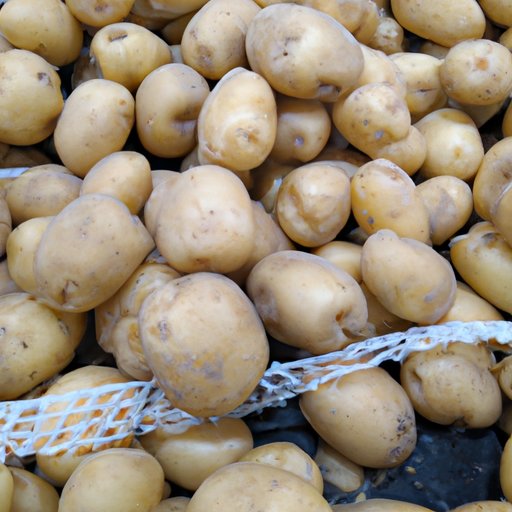
I. Introduction
Have you ever encountered rotten potatoes in your pantry or fridge? It’s a common problem that many people face. This article will provide you with tips and tricks on how to spot and prevent potato spoilage so you won’t have to throw them away
II. How to Spot Spoiled Potatoes
One of the easiest ways to spot spoiled potatoes is visually. Look for dark spots, discoloration, or sprouts. If you see greenish or black spots, it usually indicates that the potato is going bad. Another sign is wilting or wrinkled skin.
Aside from visual cues, the smell and texture can also provide a clue. If it smells musty or sour, the potato is no longer fresh. If it feels soft or slimy, it needs to be tossed out.
III. Uncovering the Shelf Life of Potatoes
The shelf life of potatoes depends on the type of potato and how they are stored. Generally, potatoes can last up to several weeks to several months if stored properly. Russet potatoes can last up to a month, while red or white potatoes can last up to two months. Sweet potatoes can last up to three months.
To extend the shelf life of potatoes, they should be stored in a cool and dry place, away from light. It’s best to store them in a paper bag or mesh bag to allow air circulation. Avoid storing potatoes with onions, as they can speed up the spoiling process.
To check if you can still consume potatoes, do a sniff and squeeze test. If it smells fresh and feels firm, then it’s good to go.
IV. Differentiating between Good and Bad Potatoes
When shopping for potatoes, look for clean and firm potatoes without any obvious blemishes. The skin should be smooth and without any wrinkles. Fresh potatoes have a slightly sweet smell.
Good potatoes have a uniform color and texture, while bad potatoes vary in color and texture, with spots or bruises. Fresh potatoes have a firm texture and don’t easily break apart. In contrast, bad potatoes feel soft and mushy.
The key to handling potatoes to avoid spoilage is to avoid bruising them. Rough handling can damage the cells and cause the potato to go bad quickly.
V. Food Safety Alert: How to Avoid Consuming Rotten Potatoes
Consuming rotten potatoes can cause food poisoning, which makes it important to know how to avoid them. Symptoms of food poisoning from bad potatoes may include nausea, vomiting, and diarrhea.
When you suspect that potatoes have gone bad, don’t take any chances. Throw them out immediately. When cooking potatoes, make sure that they are cooked to a temperature of at least 135°F to kill any harmful bacteria.
If someone accidentally eats rotten potatoes, watch out for any symptoms of food poisoning. Rehydration with water or electrolyte solutions is essential to replenish fluids lost due to diarrhea or vomiting.
VI. How to Store Potatoes So They Don’t Go Bad
Refrigeration is not recommended for storing potatoes, as it can convert the starch to sugar and affect the texture and taste of the potato. Instead, store them in a cool, dry, and dark place, such as a pantry or basement storage area.
Proper ventilation is also essential to prevent spoilage. Don’t store potatoes in a plastic bag, as it traps moisture and promotes the growth of harmful bacteria. Instead, store them in a paper or mesh bag to allow for air circulation.
It’s best to keep potatoes away from direct light, as it can cause the skin to turn green and produce solanine, which is toxic in high doses.
VII. Conclusion
To keep your potatoes fresh and safe to eat, follow these tips:
- Look for visually detectable signs of potato spoilage
- Know the shelf life of different types of potatoes
- Differentiate between good and bad potatoes when shopping
- Avoid consuming rotten potatoes and properly cook potatoes to prevent food poisoning
- Store potatoes in a cool, dry, and dark place with proper ventilation and away from light.
By following these tips, you can enjoy fresh and healthy potatoes every time.




